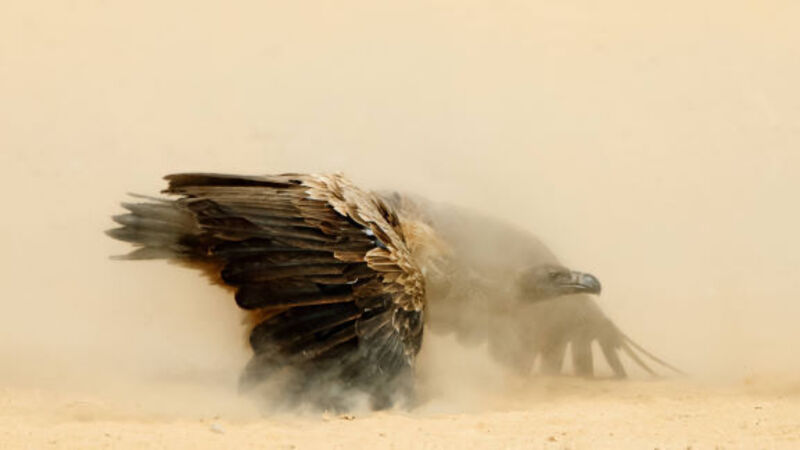Prizewinning pic from Irish photographer featured in top wildlife shots

A PETER DELANEY photograph is one of the 100 in this year’s Wildlife Photographer of the Year exhibition, which is in Ireland for the first time after a spell at its annual home, the Natural History Museum in London.
The Irish photographer’s prize-winning shot is called ‘Showdown’ and depicts a vulture on the edge of a violent scrap for antelope carcasses. Two things immediately struck Delaney when he came upon the ruckus, at a watering hole in southern Africa’s Kgalagadi Transfrontier Park — the revolting stench of rotting flesh and the intense, buzzing sound of flies.
“I was driving along a dry river bed,” says Delaney. “I noticed there were a lot of dead elands, which are one of the biggest antelopes in Africa, all around the place. I thought, ‘what’s going on here’? I realised the rains hadn’t been for a long time, that the animals were dying of starvation because there was no food around. There was easy pickings for the predators.
“Even though there was water at the waterhole, there was no food around, except 12 or 13 carcasses. There were hundreds of vultures and lions. It was in the middle of the day — the worst time of day to photograph, according to the rules, yet there was so much going on I spent two or three hours photographing the interaction.
“The guy in ‘Showdown’ was having a fight with another, white-backed vulture. He just pulled back, spread himself out and made himself look bigger, and then pounced again. That’s when I got him — with the dust flying, the feathers in the air. It was one of those shots you knew, as you were clicking — ‘yes, I got it’. I don’t think I could ever do better photographing vultures. I would never surpass it — the steely eye, the way he’s looking, the dust all around. He’s ready to engage again.”
Delaney, who grew up in Avoca, Co Wicklow, came late to the photographer’s ball. He spent the 1990s in the money markets, as a broker in London and Tokyo, but he jacked it in for the lure of Africa.
He spent a year trucking around the continent, at the early part of the last decade, and became enchanted.
“I stayed a month or two in each country, driving from South Africa up to Uganda. The whole idea was I was going to drive back to Dublin. I suddenly realised, while I was in Uganda, I didn’t want to be a money broker anymore and went back to South Africa, and ended up buying a house here,” he says.
Once Delaney settled in South Africa, he took ranger courses, so he could gen up on flora and fauna, and read animal tracks, and the like. By 2006, he was sufficiently accomplished to go full-time as a professional wildlife photographer. Along the way, he managed the “daunting” migration from film to digital.
“Before, with a slide, you took your film out and took it to a retail outlet and they would develop it, and print it. It was hands-off — the editing side of it — for the photographer, unless you were doing black and white, where you took it into your own dark room.
“With digital photography, you work with a raw image and that raw image is only half-processed once you click the shutter.
“Then, you have to load it onto your computer. Then, you have to take it into a raw converter and into Photoshop.
“That’s where the real creativity comes. For those who have not done Photoshop before, or who are starting out, it’s quite a difficult programme to learn. Once you get the hang of it, it’s a fantastic tool.”
Delaney likes to work on his own, often for up to a month at a time. It means he has to be self-sufficient when he’s in the bush, where he’s beyond mobile phone range, and without anybody to help if something goes awry.
“I’ve been charged by elephants,” he says. “Don’t tell my mother — she’d kill me — but there have been many times where I’ve been in situations where I’ve thought, ‘Oh hell, how am I going to get out of this?’ I had a situation with a leopard, when I thought it was really going to take me out. I’ve had a lion so close I could put my hand out and touch it, but it’s all calculated.
“Whenever I’m out in the bush, I always like the subject to approach me. The thing with animals is once they know they’re approaching you, and that they’re in your zone, then that’s OK. If you go into their space, you’re into a flight-or-fight situation. That’s what you don’t want.
“It’s all about learning the behaviour of a particular animal. When a male and female lion are mating, for example, I know, when he pulls out, she will turn around and slap him because it’s very sore for her. Just when he’s dismounting, I know that’s when I’m going to hit my shutter button on my camera to get that reaction.”
For Delaney, it’s an approach that has reaped a reward in an impressive portfolio of stunning images.











